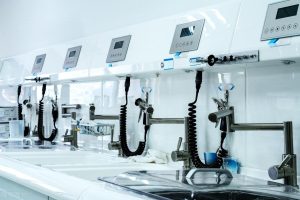A Comprehensive Guide to International Standards, Ranges, and Benefits
Medical devices play a critical role in healthcare, helping doctors diagnose, treat, and monitor patients. However, when medical devices are not appropriately sterilized, they can pose a significant risk to patients by transferring harmful bacteria, viruses, and other microorganisms. To ensure the safety of medical devices, manufacturers must adhere to strict sterilization protocols. In this article, we will discuss the three levels of medical device sterility, their corresponding ranges, and the international standards that define them. We will also explore the benefits of each level and how they ensure the safety of medical devices.

What are the three levels of sterility?
The three levels of medical device sterility are:
Sterile: A sterile device is free from all viable microorganisms, including bacteria, viruses, fungi, and spores. Sterilization is achieved through a variety of methods, including steam, ethylene oxide gas, and radiation.
High-level disinfection: A device that undergoes high-level disinfection is free from all microorganisms except for a small number of bacterialspores. High-level disinfection is achieved through chemical disinfectants or a combination of chemical disinfectants and physical methods such as heat.
Intermediate-level disinfection: A device that undergoes intermediate-level disinfection is free from most microorganisms, including bacteria, viruses, and fungi. Intermediate-level disinfection is achieved through chemical disinfectants.
International standards for the definition of three levels of sterility
The international standard that defines the three levels of medical device sterilization is ISO 17665. ISO 17665 specifies the requirements for the development, validation, and routine control of a sterilization process for medical devices. It also provides guidance on selecting the appropriate sterilization method based on the device's material, design, and intended use.
What ranges do the three levels of sterility correspond to?
The ranges of the three levels of medical device sterility are:

Sterile: A sterile device has a sterility assurance level (SAL) of 10^-6, which means that there is a one in a million chance that a viable microorganism is present on the device after sterilization.
High-level disinfection: A device that undergoes high-level disinfection has a log reduction of at least 6, which means that the number of microorganisms on the device is reduced by a factor of one million.
Intermediate-level disinfection: A device that undergoes intermediate-level disinfection has a log reduction of at least 4, whichmeans that the number of microorganisms on the device is reduced by a factor of ten thousand.
Benefits of three levels of sterility

The three levels of medical device sterility ensure that medical devices are free from harmful microorganisms, reducing the risk of infection and cross-contamination. Sterile devices are used for invasive procedures, such as surgeries, where any contamination can cause severe infections. High-level disinfection is used for semi-critical devices, such as endoscopes, that come into contact with mucous membranes but do not penetrate them. Intermediate-level disinfection is used for non-critical devices, such as blood pressure cuffs, that come into contact with intact skin. By using appropriate levels of sterilization, medical professionals can ensure that patients are protected from harmful microorganisms.
Summary
In summary, the three levels of medical device sterility are sterile, high-level disinfection, and intermediate-level disinfection. These levels ensure that medical devices are free from harmful microorganisms and reduce the risk of infection and cross-contamination. ISO 17665 is the international standard that defines the requirements for the development, validation, and routine control of a sterilization process for medical devices. The ranges of the three levels of sterility correspond to a SAL of 10^-6 for sterile devices, a log reduction of at least 6 for high-level disinfection, and a log reduction of at least 4 for intermediate-level disinfection. By adhering to appropriate levels of sterilization, medical professionals canensure that patients are protected from harmful microorganisms, and medical devices are safe to use.